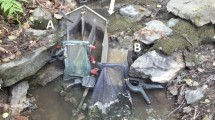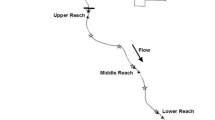Summary
Larger nymphs within aquatic insect taxa have been frequently observed to be transported down-stream in the stream drift only at night. Others have hypothesized this pattern results primarily from large nymphs' behavioural avoidance of entering drift during daylight, when size-selective, visually-feeding fish predators are most active. This hypothesis assumes that animals can actively control their entry into the drift, which may not be the case under all flow conditions. We experimentally induced streamflow increases and decreases in adjacent riffles in a hydrologically-stable stream during the daytime to examine whether changes in diel patterns of drift abundance and size-distribution of mayflies were consistent with the hypothesis of active avoidance of diurnal drift. We assessed the likelihood of active vs. passive mechanisms of diurnal drift entry and transport for four taxa that differ with respect to body size, morpho-behavioural attributes, microhabitat use, and general propensity to drift. In each of three seasons, diurnal and nocturnal drift samples were collected in three riffles over two diel cycles. Background drift patterns were established on the first day (no flow manipulation). Six h before sunset on the second day, flow was experimentally increased in one riffle, decreased in the second, and not altered in the third (control). Between-day differences in diurnal and nocturnal drift rate and size composition were then compared among the treatment and reference riffles. Responses of two taxa were consistent with active control over drift entry, transport, or both. For Baetis spp., drift-prone mayflies typically preyed upon by fish, diurnal drift rates immediately increased following both flow reduction and flow elevation in all seasons, but only small individuals comprised the drift. Drift by large individuals was delayed until nighttime. Epeorus longimanus also exhibited significant increases in drift rates following flow reduction and elevation, but responses of this large-bodied species were restricted to nighttime. Drift responses for these two taxa were largely independent of direction of hydrologic change, thus indicating a strong behavioural control over drift. By contrast, numbers and sizes of drifting Paraleptophlebia heteronea and Ephemerella infrequens depended strongly on direction of flow change. Drift rates for both species generally declined after flow reduction and increased after flow elevation. Moreover, after flow elevation, larger individuals often drifted diurnally, a finding consistent with expectations under a passive hydrodynamic model. These experiments indicate that size-dependent mayfly drift reflects not only presumed risk from visual fish predators, but also functional attributes of species such as morphology, behaviour, and microhabitat affiliation, which influence aspects of drift entry and transport under variable hydrologic conditions.
Similar content being viewed by others
References
Allan JD (1978) Trout predation and the size composition of stream drift. Limnol Oceanogr 23:1231–1237
Allan JD (1981) Determinants of diet of brook trout (Salvelinus fontinalis) in a mountain stream. Can J Fish Aquat Sci 38:184–192
Allan JD (1984) The size composition of invertebrate drift in a Rocky Mountain stream. Oikos 43:68–76
Allan JD (1987) Macroinvertebrate drift in a Rocky Mountain stream. Hydrobiologia 144:261–268
Allan JD, Feifarek BP (1989) Distances travelled by drifting mayfly nymphs: factors influencing return to the substrate. J N Am Benthol Soc 8:322–330
Allan JD, Russek E (1985) The quantification of stream drift. Can J Fish Aquat Sci 42:210–215
Allan JD, Flecker AS, McClintock NL (1986) Diel epibenthic activity of mayfly nymphs, and its nonconcordance with behavioral drift. Limnol Oceanogr 31:1057–1065
Andersson KA, Brönmark C, Hermann J, Malmqvist B, Otto C, Sjöström P (1986) Presence of sculpins (Cottus gobio) reduces drift and activity of Gammarus pulex (Amphipoda). Hydrobiologia 133:209–215
Brittain JE, Eikeland TJ (1988) Invertebrate drift — a review. Hydrobiologia 166: 77–93
Butz I (1973) Strömungsverhalten von Ephemerella ignita (Ephemeroptera). Oikos 24:469–472
Campbell RNB (1985) Comparison of the drift of live and dead Baetis nymphs in a weakening water current. Hydrobiologia 126:229–236
Carpenter SR (1990) Large-scale perturbations: opportunities for innovation. Ecology 71:2038–2043
Ciborowski JJH (1983) Influence of current velocity, density and detritus on drift of two mayfly species. Can J Zool 61:119–125
Ciborowski JJH, Corkum LD (1980) Importance of behaviour to the re-establishment of drifting Ephemeroptera. In: Flannagan JG, Marshall KE (eds) Advances in ephemeropteran biology. Plenum, New York, pp 321–330
Ciborowski JJH, Pointing PJ, Corkum LD (1977) The effect of current velocity and sediment on the drift of the mayfly Ephemerella subvaria McDunnough. Freshwater Biol 7:567–572
Corkum LD (1978) The influence of density and behavioral type on the active entry of two mayfly species (Ephemeroptera) into the water column. Can J Zool 56:1201–1206
Corkum LD, Clifford HF (1980) The importance of species avoidance and substrate types to behavioral drift. In: Flannagan JG, Marshall KE (eds) Advances in ephemeropteran biology. Plenum, New York, pp 331–341
Corkum LD, Pointing PJ, Ciborowski JJH (1977) The influence of current velocity and substrate on the distribution and drift of two species of mayflies (Ephemeroptera). Can J Zool 55:1970–1977
Cunjak RA (1987) The feeding energetics of stream-resident trout in winter. J Fish Biol 31:493–511
Edmunds GF, Jensen SL, Berner L (1976) The mayflies of North and Central America. Univ. Minnesota Press, Minneapolis
Elliott JM (1968) The daily activity patterns of mayfly nymphs (Ephemeroptera). J Zool Lond 155:201–221
Elliott JM (1971) The distances travelled by drifting invertebrates in a Lake District stream. Oecologia 6:191–220
Elliott JM (1973) The food of brown and rainbow trout (S. trutta and S. gairdneri) in relation to the abundance of drifting invertebrates in a mountain stream. Oecologia 12:329–347
Flecker AS (1992) Fish predation and the evolution of invertebrate drift periodicity: evidence from Neotropical streams. Ecology 73 (in press)
Gore JA (1977) Reservoir manipulations and benthic macro-invertebrates in a prairie river. Hydrobiologia 55:113–123
Hurlbert SH (1984) Pseudoreplication and the design of ecological fixed experiments. Ecol Monogr 54:187–211
Malmqvist B, Sjöström P (1987) Stream drift as a consequence of disturbance by invertebrate predators: field and laboratory experiments. Oecologia 74:396–403
Minshall GW, Winger FV (1968) The effect of reduction in stream flow on invertebrate drift. Ecology 49:580–582
Newman RM, Waters TF (1984) Size-selective predation on Gammarus pseudolimnaeus by trout and sculpins. Ecology 65:1535–1545
Nehring RB (1987) Stream fisheries investigations no. F-51-R, Colorado Division of Wildlife, Fish Research Section, Ft. Collins, CO
Poff NL, Ward JV (1989) Implications of streamflow variability and predictability for lotic community structure: a regional analysis of streamflow patterns. Can J Fish Aquat Sci 46:1805–1818
Poff NL, Ward JV (1991) Drift responses of benthic invertebrates to experimental hydrologic variation in a regulated stream. Can J Fish Aquat Sci 48 (in press)
Rader RB, Ward JV (1989) Influence of impoundments on mayfly diets, life histories, and production. J N Am Benthol Soc 8:64–73
Rader RB, Ward JV (1990) Diel migration and microhabitat distribution of a benthic stream assemblage. Can J Fish Aquat Sci 47:711–718
Ringler NH (1979) Selective predation by drift-feeding brown trout (Salmo trutta) J Fish Res Bd Can 36:392–403
Skinner WD (1985) Night-day drift patterns and the size of larvae of two aquatic insects. Hydrobiologia 124:283–285
Statzner B (1988) Growth and Reynolds number of lotic macroinvertebrates: a problem for adaptation of shape to drag. Oikos 51:84–87
Statzner B, Holm TF (1982) Morphological adaptations of benthic invertebrates to stream flow-an old question studied by means of a new technique (laser doppler anemometry). Oecologia 53:290–292
Statzner B, Holm TF (1989) Morphological adaptation of shape to flow: microcurrents around lotic macroinvertebrates with known Reynolds numbers at quasi-natural flow conditions. Oecologia 78:145–157
Steel RGD, Torrie JH (1980) Principles and procedures of statistics: a biometrical approach (2nd ed.) McGraw-Hill Book Co., New York
Stewart-Oaten A, Murdoch WW, Parker KR (1986) Environmental impact assessment: “pseudoreplication” in time? Ecology 67:929–940
Waters TF (1972) The drift of stream insects. Ann Rev Entomol 17:253–272
Wilzbach MA (1990) Nonconcordance of drift and benthic activity in Baetis. Limnol Oceanogr 35:945–952
Wilzbach MA, Cummins KW, Knapp RA (1988) Toward a functional classification of stream invertebrate drift. Verh Internat Verein Limnol 23:1244–1254
Author information
Authors and Affiliations
Rights and permissions
About this article
Cite this article
Poff, N.L., DeCino, R.D. & Ward, J.V. Size-dependent drift responses of mayflies to experimental hydrologic variation: active predator avoidance or passive hydrodynamic displacement?. Oecologia 88, 577–586 (1991). https://doi.org/10.1007/BF00317723
Received:
Accepted:
Issue Date:
DOI: https://doi.org/10.1007/BF00317723




